| Pentax/Camera Marketplace |
| Pentax Items for Sale |
| Wanted Pentax Items |
| Pentax Deals |
| Deal Finder & Price Alerts |
| Price Watch Forum |
| My Marketplace Activity |
| List a New Item |
| Get seller access! |
| Pentax Stores |
| Pentax Retailer Map |
| Pentax Photos |
| Sample Photo Search |
| Recent Photo Mosaic |
| Today's Photos |
| Free Photo Storage |
| Member Photo Albums |
| User Photo Gallery |
| Exclusive Gallery |
| Photo Community |
| Photo Sharing Forum |
| Critique Forum |
| Official Photo Contests |
| World Pentax Day Gallery |
| World Pentax Day Photo Map |
| Pentax Resources |
| Articles and Tutorials |
| Member-Submitted Articles |
| Recommended Gear |
| Firmware Update Guide |
| Firmware Updates |
| Pentax News |
| Pentax Lens Databases |
| Pentax Lens Reviews |
| Pentax Lens Search |
| Third-Party Lens Reviews |
| Lens Compatibility |
| Pentax Serial Number Database |
| In-Depth Reviews |
| SLR Lens Forum |
| Sample Photo Archive |
| Forum Discussions |
| New Posts |
| Today's Threads |
| Photo Threads |
| Recent Photo Mosaic |
| Recent Updates |
| Today's Photos |
| Quick Searches |
| Unanswered Threads |
| Recently Liked Posts |
| Forum RSS Feed |
| Go to Page... |
 |
| 4 Likes | Search this Thread |
| 07-02-2010, 01:20 AM | #91 |
| Of course one might have 42- or even 48-bit RAW and process only with Adobe RBG or other superior color space - BUT when one has to display the thing on the web it has to be one of the common graphics files like JPG, and has to be sRGB...... so what becomes of one's 48-bit color wide gamut? Just think about it, it's the same as color bit depth: at the end you have to convert to 8 bit for JPG, but still using all the original 12/14 bit info from your cam till the end is preferable and has its advantages. No wonder all the big pp apps use Prophoto RGB and 16 bit for internal RGB operations  RAW and any wider gamut processing is not going to help if that part of the spectrum is not captured in the first place.  | |
| 07-02-2010, 02:34 AM | #92 |
| K-x Dynamic range
Just to chip in my 2 pence, I'm really blown away by the dynamic range of the k-x. This was shot jpeg, center weighted metering, aperture priority, auto wb. No pp at all, just been resized: iso 100, f/4, 1/1000, 12mm | |
| 07-02-2010, 09:23 AM | #93 |
| Even though we usually have to convert to sRGB at the end for web/email, using a wide color space still have its advantages. If all of the internal RGB operations are done in the tiny sRGB space then you throw out much of the color data recorded by your cam right at the beginning, because sRGB (and even AdobeRGB) is much smaller than the gamut of your cam. Having and working with all the original colors from right after demosaicing till saving to JPG is much better than trowing out nearly half of the colors right after demosaicing. My english is not that good to explain it in deeper, but you can read many articles on this. For example this and the "further reading" links at the end. Just think about it, it's the same as color bit depth: at the end you have to convert to 8 bit for JPG, but still using all the original 12/14 bit info from your cam till the end is preferable and has its advantages. No wonder all the big pp apps use Prophoto RGB and 16 bit for internal RGB operations  However it is still hard to imagine how a final sRGB image is better if it was 14- or 12-bit per color literally moments before saving to sRGB and an original sRGB image - unless of course there were gross losses or clipping during the PP due to the lower gamut. I mean take for example saving to JPG - I challenge almost anyone to see the difference between saving in JPG say in PhotoShop Elements (7.0) at the Max level of 12 and the max level of 10 - there is quite a large difference in size - and this would be considered a Gross difference - I think most poeple would not physically see a difference by eye only - yet we all know that JPG compression is lossy and the initial losses are in the colors - mostly what I'd call the in-between shades - this is probably the same effect of starting with 14- or 12-bit per color image and saving to sRGB JPG at the very last moment and an original sRGB JPG - in fact the JPG might look better - just because of the user operations on the original 14- or 12-bit RAW image. Try it sometime - shoot a paired RAW+JPG and use any RAW processor (other than Pentax DCU/SilkyPix) and save to JPG - and see if one can actually manage to match the untouched JPG - sounds simple enough until one tries it - it really is a pretty "acid test" - if not much difference can be seen - this merely shows that 14- or 12-bit per color RAW may well be superior - and I'll will absolutely concur - but then where is this superiority in real-life practice? >> then think about this - how long did it take to match the original JPG? and just how long did it take to have the original JPG quality with the original JPG? And - this is the acid (biting) bit - if there is a perceptible difference - this means that even with all the RAW control and advantages one could NOT match even a simple JPG! so even with the much touted use RAW and all your problems (including world peace   ) will be solved - ) will be solved - would not be able to do it....... So to summarize I freely agree that RAW is vastly superior - BUT RAW does absolutely nothing to be able to capture deep violet (380-420nm) as it is not captured by the camera in the first place. Also even if RAW has a much wider gamut color space - it is hard to show real-world advantages once saved to JPG compared to a minimally PP JPG. | |
| 07-02-2010, 11:14 AM | #94 |
| Veteran Member      | Thank you for being kind and cutting me some slack - however that quote/link from the Wikipedia I feel is pretty accurate - violet is a well known wavelength (range) of light in the spectrum - purple is an extra-spectral color...... so not part of the true spectrum. Wonderful discussion - thank you so much. Last edited by Marc Sabatella; 07-02-2010 at 11:22 AM. |
| 07-02-2010, 11:47 AM | #95 |
| In that world, yes, that distinction is common. I'm just saying it isn't universal. I come from the art world, and except among color theorists, this distinction is not made. We regular use the term "violet" to describe colors that are actually "purple" by this measure, whether the result of subtractive mixing of color or a pigment that actually reflects red and blue. I don't just mean that "uneducated" artists speak this way colloquially. I mean, the actual official names and color index numbers of the pigments used are all "violet"(Quinacridone Violet / PV19, etc) regardless of the actual spectral reflectance. But in this more definitive (scientific) case it actually made a difference - and my attempt at "clarification" actually resulted in some muddling - obviously not enough to fool anyone - but it was there nevertheless, and for the sake of clarity I had to point it out - albeit in appearing to be pedantic. However it did in the end make a difference as an probable explanation why my last three shots seem to show purple whereas the previous shots from both the K-x and even Canon G10 singularly failed to show the violet I saw. so as they say honesty, or clarity, is the best policy. and after all I started all this bit about the inability of the K-x (very much on topic) to capture the deep (true) violet that my eyes saw - it's just that applies to almost any digicam - and there is a difference between true violet and the often equated color purple - as illustrated by my two sets of photos showing only deep blue vs. showing purple. Honest, I didn't plan this - it came out only because of the great discussion we have on this thread and in particular that post over at CPF. I am very grateful for all this - because it now gives me a much better understanding of the limitations of my K-x (and probably any other digicam) Last edited by UnknownVT; 07-02-2010 at 12:14 PM. | |
| 07-03-2010, 02:02 AM | #96 |
 so even with the much touted use RAW and all your problems (including world peace   ) will be solved - ) will be solved - would not be able to do it.......  until I faced its limitations too often. I'd say for ~80% of my photos shooting raw doesn't make much difference (in image quality), but there's that 20% where raw "saved the shot" (either literally or resulting in a much pleasing image). And sometimes you can have that "once in a lifetime" photo in the 20% group. until I faced its limitations too often. I'd say for ~80% of my photos shooting raw doesn't make much difference (in image quality), but there's that 20% where raw "saved the shot" (either literally or resulting in a much pleasing image). And sometimes you can have that "once in a lifetime" photo in the 20% group.Also even if RAW has a much wider gamut color space - it is hard to show real-world advantages once saved to JPG compared to a minimally PP JPG. Also, in the coming 3-6 years wide gamut monitors will become quite common and in my (limited) experience they do make a difference. Ps: sorry for the topic hijack  | |
| 07-03-2010, 07:26 AM | #97 |
| Again, it depends on the image. I have dozens of examples on my HDD showing real world advantages - cam jpg with color clipping and therefore lack of details, or even false colors versus raw conversion with no clipping, visible details and more proper colors. Also, in the coming 3-6 years wide gamut monitors will become quite common and in my (limited) experience they do make a difference. Ps: sorry for the topic hijack  There is no problem re: hi-jack it isn't - we're both on topic. As many say the proof of the pudding is in the eating - and this is after all a photographic forum - so I'd be very grateful if you could please use a paired RAW+JPG and show the advantage of the wider gamut after you converted and saved to JPG (to match the original JPG) - over the original unprocessed JPG on our monitors? - please preserve the EXIF metadata so that there are no doubts that those were paired. Your example of the article about the advantages of wider gamut working: For example this and the "further reading" links at the end. neither do the two further reading articles - why? I know I have "fiddled" with RAW+JPG - but haven't seen any obvious advantages - but perhaps it's simply because I have been using conventional editors and probably just in sRGB. You may have to point out and/or highlight the specific areas for my "uneducated" eyes - but I'm sure once pointed out they ought to be obvious? Thanks, Last edited by UnknownVT; 07-03-2010 at 07:33 AM. | |
| 07-03-2010, 08:19 AM | #98 |
 to the person with the violet/blue problem, what white balance setting are you using? I shot this 2 nights ago during the Canada Day fireworks, and for a goof i set the white balance from auto to Tungsten , and it made the dark purple clouds show up as blue | |
| 07-03-2010, 10:21 AM | #99 |
| Thanks for your input. I used K-x AWB. The problem is not just the white balance as explained above in Post #88 - most dSLRs (and digicams) have a cutoff at about 455nm - which is above true violet (380-420nm) so true violet is not captured at all - only the (adjacent) deep blue components - that is why true violet ends up being shown as deep blue. White balance probably will not make a difference or help - since the true violet wavelength is not captured in the first place. Last edited by UnknownVT; 07-03-2010 at 11:35 AM. | |
| 07-05-2010, 02:33 PM | #100 |
|
More on LED and/or mono-colored lighting as well as the dreaded magenta (made up of Red and Blue LEDs). Last night I was at the same LED lit venue and the lighting seemed particularly difficult - in terms of very strong mono-blue and magenta - Just to give an example - 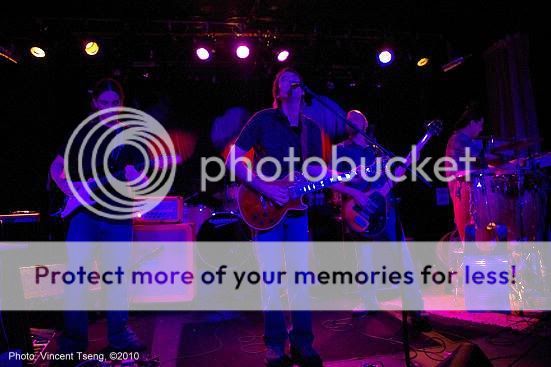 EXIF still attached (caveat PhotoBucket can mysteriously drop metadata) un-retouched other than resize and standard sharpening. Notice despite the fact I had sharpened this it still look mushy when saved to my standard JPG compression. - of course the original looks better - the way I mitigated this was to have to do some severe post processing. Normally I would attempt to select either a white or gray point - but there wasn't any suitable area - and not only that when I picked likely points (eg: the guitar white pick-guard) the whole background turned green - so this was a particularly difficult photo. My PP result -  use of enhanced lighting (fill-flash in PP) then color balanced toward green and that was some 50% of setting maximum - all this emphasized the noise somewhat - but overall I think it is a lot more acceptable than the original. (Link to first photo of 10) In a few instances I managed to mitigate the strong and difficult lighting by supplementing with flash - this basically adds some more neutral white light to the mix - this is a pretty dramatic example - both with EXIF still attached so one can check the settings - taken literally seconds apart - so there might have been some lighting change - but fairly unlikely. Again no PP other than resize and standard sharpening. No flash as-is - 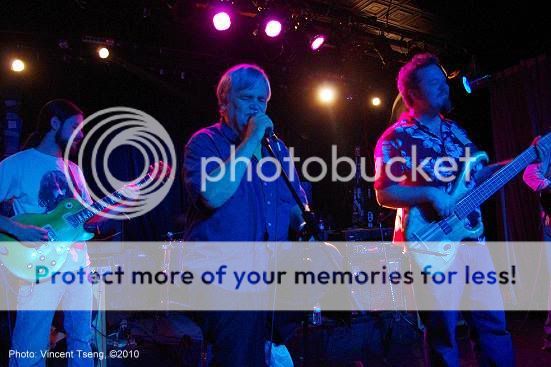 Fill-in (slow sync) flash at -1 stop flash compensation 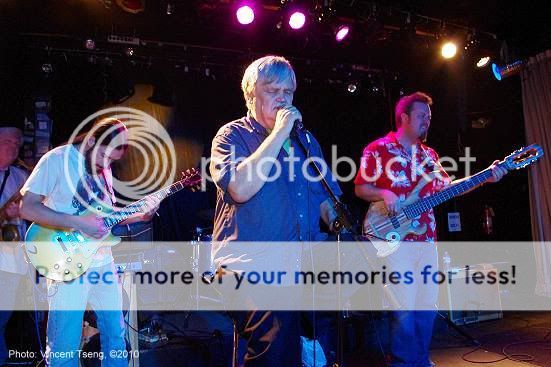 I consider the flash shot much better and still manages to look almost like a non-flash shot - it certainly has mitigated the overall strong blue wash. This was a particularly effective and dramatic example - but even fill-flash is not a guarantee - but mostly does quite well. Lots of shots were kind of same-y because of the lighting for example this shot of the guitarist was one in several with the same lighting -  and I wanted to post two (good) shots - but they would have looked similar due to the same lighting which was not particularly flattering in the first place - so I did some radical PP to get a more natural balance - so that I could have at least different looking shots -  I did my balance corrections by a simple select white point on the T-shirt - and miraculously it came out like this - remember I am only using JPGs here (I await a response that will tell me I could do better, and solved all my problems with RAW... plu-eease!  ) )Here's another shot that I really had to work at - 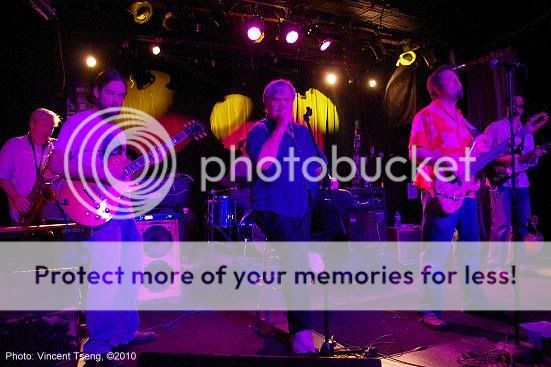 again not easy white or gray point After: 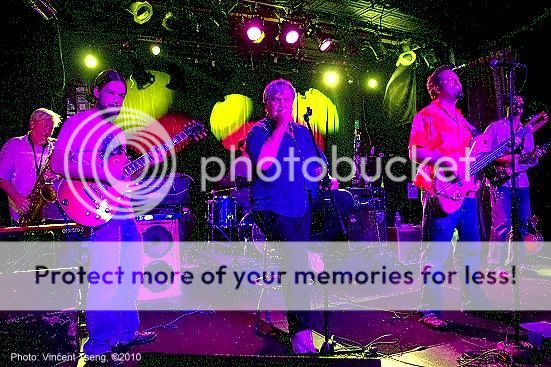 some radical and heavy balance toward green to get even this...... this balance toward (basically adding) green mitigated the severe loss of detail in the magenta lighting - look at the guitarist's face on the left. I think for my usage the fill slow-sync flash probably does the best - but I normally prefer not to use flash - but the lighting was so difficult - by the end of the evening I just felt I had to..... as soon as I saw took a shot of strong mono-colored or magenta lighting 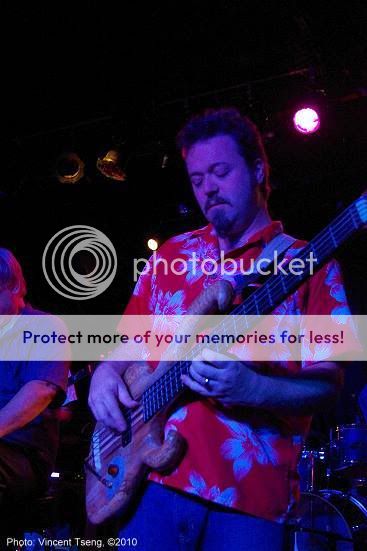 I popped up my flash for fill-in slow-sync with -1 stop flash compensation: 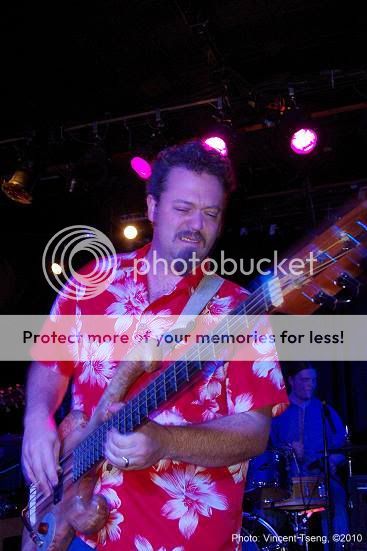 EXIF still attached taken seconds apart - no PP re-touching other than resize and standard sharpening. Link to first photo of 23 | |
| 07-09-2010, 01:12 PM | #101 |
|
Didn't go back to the dark jazz club last night with posting photos in this thread in mind - went just because the music and the photography are always interesting -  this week the lights in the alcove at the back of the stage were on. So - 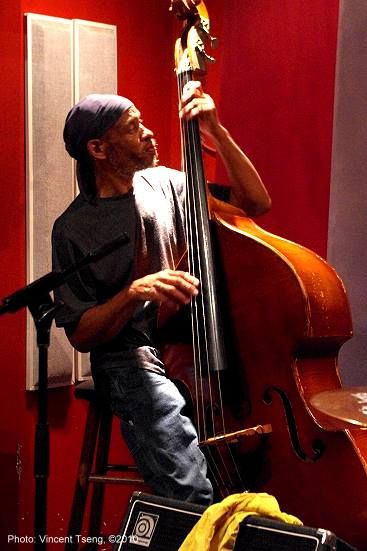 I'm getting better shots of the rhythm section. The first scene setting photo was more significant - started with a riff on the electric piano - that was like an Afro-beat tune by the regular pianist - but this time out in the light - 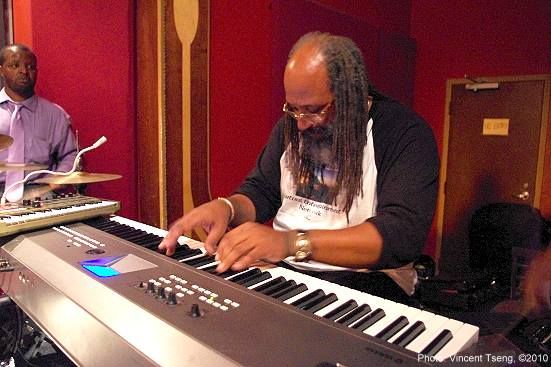 Then the horns came in on the chorus - from off stage (in the dark)  I recognized it as a Fela Kuti tune - "Water No Get Enemy" - one of my favorites - then Dashill Smith jumped up on stage to sing some of the lyrics - the house was rockin' - 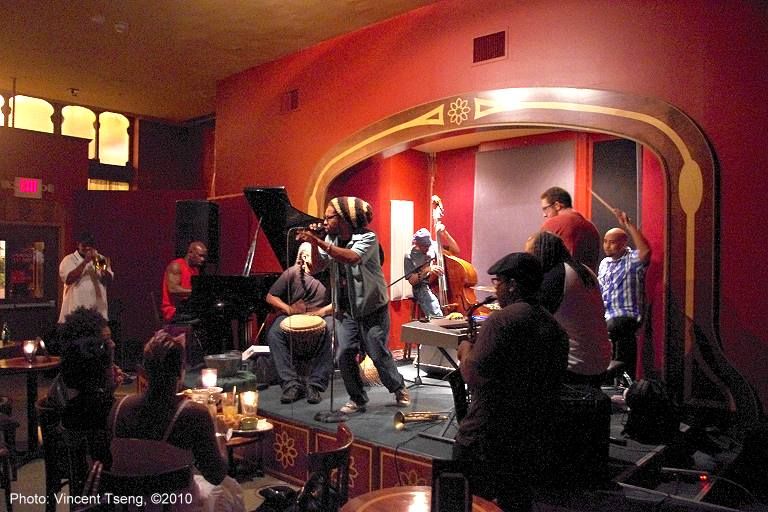 EXIF attached - ISO5000, f/3.5, 1/15sec, 18mm more shots - 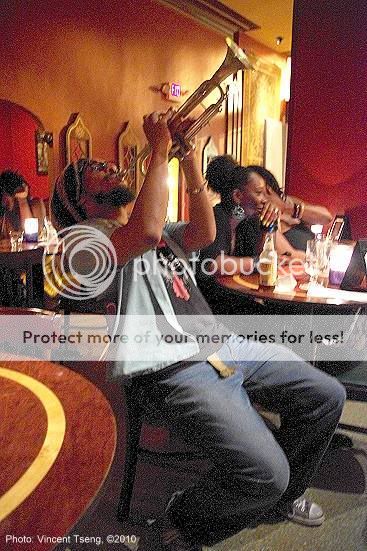  on vocoder...... then trading scat - 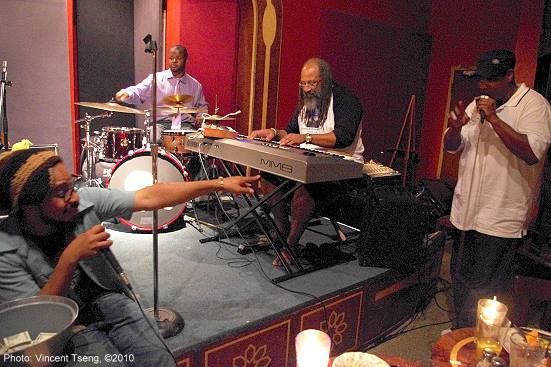 with playing off stage - from the back -  EXIF attached - ISO5000 f/3.5. 1/4 sec, 18mm - I'm surprised that I could even focus - much less get a presentable shot (I added a bit of blue using color balance - not enough to show, but enough to help keep any details when saved to jpg.) and the drummer is on piano - 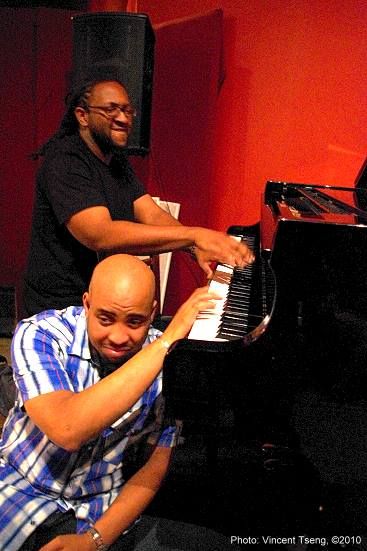 well OK one-handed - (phone in the other!) more "audience participation" -  notice how bright the outside average street lighting is? almost looking like daylight in comparison to inside....... Last edited by UnknownVT; 07-10-2010 at 09:06 AM. | |
| 07-09-2010, 03:26 PM | #102 |
|
Great photos, you must have a rock solid shooting stance. That venue looks like a mad-house  But fun. In one or two of the pix the noise has corroded away a little too much of the image quality but they still are good captures. Perhaps as monochromes the most grainy of those would actually look quite cool. But fun. In one or two of the pix the noise has corroded away a little too much of the image quality but they still are good captures. Perhaps as monochromes the most grainy of those would actually look quite cool.What ISO do you have your high-ISO NR set to start working from? And what is it set at? And yeah, from the glimpses of the outside we can see, I thought it was a daylight gig until you said it was just street lighting. That's pretty awesome. | |
| 07-09-2010, 10:41 PM | #103 |
| Great photos, you must have a rock solid shooting stance. That venue looks like a mad-house  But fun. In one or two of the pix the noise has corroded away a little too much of the image quality but they still are good captures. Perhaps as monochromes the most grainy of those would actually look quite cool. But fun. In one or two of the pix the noise has corroded away a little too much of the image quality but they still are good captures. Perhaps as monochromes the most grainy of those would actually look quite cool.What ISO do you have your high-ISO NR set to start working from? And what is it set at? And yeah, from the glimpses of the outside we can see, I thought it was a daylight gig until you said it was just street lighting. That's pretty awesome. Yes, basically it's a ludicrous venue to shoot available light - a lot of the time I am at ISO5000, f/3.5 and 1/4sec - that's about the limits of everything including AF - and I guess why I keep going back because it is so challenging photographically - Maybe one of the pics you thought was marred by noise could be this one?  Here's the original as-is no PP other than resize and standard sharpening - 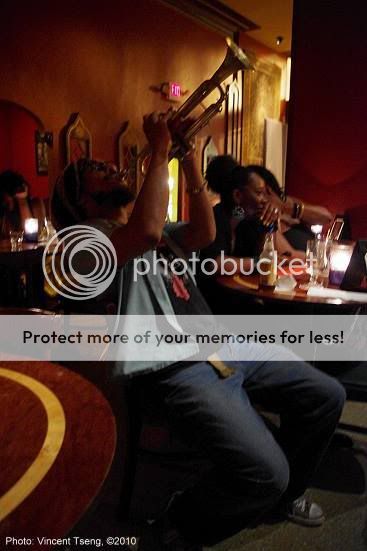 EXIF attached - ISO5000, f/3.5, 1/4sec, 18mm with the amount of enhancement in brightness level - unfortunately also brought out the noise. But I consider it more than acceptable because of the adverse condition - yes, it's an excuse - but I'm sticking to it - To even get a shot like this considering the conditions and lighting - is to my mind amazing - and truly if it wasn't for the K-x I don't think I would have managed even that. I can always use some noise reduction - but this is supposed to be a dark club and the pic looks it. Although b&w sounds OK the challenge for me is to produce shots that look like I was there - and although I've done b&w for years - they look kind like an abstraction..... My ISO setting is AutoISO with max at ISO5000 - in camera Noise Reduction is default - all the pics in this thread had this setting note all the shots I have posted from this club (and there are plenty in this thread) - it's an on-going thing - most are at ISO5000 - for you to notice only two that seem to be marred by noise - probably says something........ Many thanks for the discussion and allowing me to make excuses   Last edited by UnknownVT; 07-10-2010 at 09:06 AM. | |
| 07-10-2010, 04:06 AM | #104 |
|
Don't get me wrong Vincent, I'm jealous of your ability to get such great artistic results under very challenging lighting. I know you've explored the extremely high-ISO space before, but I guess in the case of the pic you mention, I probably would have just let the camera go to 6400 or 12800 ISO. Those crazy high ISO's might have gained you a useful stop or two at the time of the capture, and the resulting high-ISO JPG's out of the K-x aren't always awful. Might have saved you some work in PP too. But then again, in that shot of yours, you probably had the kit lens wide open at f3.5, so letting the ISO run to 6400 or even 12800 physically couldn't have gotten you a wider aperture. So the camera may have then set a slightly faster shutter speed to match the boosted sensitivity, and the result may have then been a similarly under-exposed image, just now captured at higher ISO...On second thoughts, forget about my suggestion.  | |
| 07-10-2010, 09:03 AM | #105 |
| Don't get me wrong Vincent, I'm jealous of your ability to get such great artistic results under very challenging lighting. I know you've explored the extremely high-ISO space before, but I guess in the case of the pic you mention, I probably would have just let the camera go to 6400 or 12800 ISO. Those crazy high ISO's might have gained you a useful stop or two at the time of the capture, and the resulting high-ISO JPG's out of the K-x aren't always awful. Might have saved you some work in PP too. But then again, in that shot of yours, you probably had the kit lens wide open at f3.5, so letting the ISO run to 6400 or even 12800 physically couldn't have gotten you a wider aperture. So the camera may have then set a slightly faster shutter speed to match the boosted sensitivity, and the result may have then been a similarly under-exposed image, just now captured at higher ISO...On second thoughts, forget about my suggestion.  I am always interested in better ways of beig able to capture the images I want. In the case of that image - as you probably figured it was not the ISO sensitivity - but more like the exposure/metering - again I have the K-x set for the default Multi-Segment metering which does well normally for most of my shooting - that shot was obviously fooled by the background light leakage from the street lights outside illuminating the wall behind and to the right of the trumpet. I was concentrating on him raising the trumpet that I didn't have time to chimp - if I did I would have seen the gross underexposure and just dialed in some exposure compensation - then a higher ISO would have helped because with say +1 stop compensation the shutter speed would have dropped to 1/2 sec - much too slow for me and the K-x combined - So ISO12800 would have put me back to 1/5sec - however I think the noise would be even more noticeable - sometimes luck and mistakes can be on my side...... now that one can see my "original" - the light level on the person was so low that I/K-x had difficulty focusing - I couldn't even do it manually as the image was too dark in the viewfinder to focus properly - so I had to pick an area to focus on - it was that junction between his outer shirt and the black T-shirt - now that I see the original shot myself - no wonder I could not focus on his face!   OK deNoised - and a bit less bright - more in keeping with the actual environment - howzat?! | |
 |
| Bookmarks |
| Tags - Make this thread easier to find by adding keywords to it! |
bruce, camera, dslr, f/4.5, iso, kx, lenses, nights, photography, trucks, web  |
| Top Liked Posts |
1  Post #235 by rawr Post #235 by rawr |
1  Post #15 by junyo Post #15 by junyo |
1  Post #316 by UnknownVT Post #316 by UnknownVT |
1  Post #1 by UnknownVT Post #1 by UnknownVT |

















